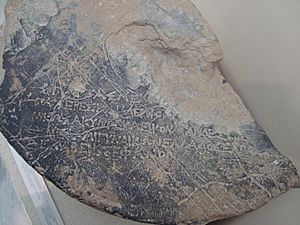Cynisca facts for kids
Cynisca (pronounced Sy-NIS-kuh) was a rich princess from Sparta in ancient Greece. She is famous for being the first woman ever to win at the Olympics. She competed in chariot racing, which was a very popular sport back then.
Cynisca first entered the Olympics in 396 BC. She won first place with a team of horses that she had trained herself. Four years later, in 392 BC, Cynisca entered her horses in the Olympics again and won another victory in the same event.
Contents
What Her Name Means
Cynisca's name means "female puppy" in Ancient Greek. She was named after her grandfather, who was called Cyniscos. This name might have come from the Spartan tradition of hunting or from her family's practice of raising hunting dogs.
Her Early Life
Cynisca was born around 442 BC in the ancient Greek city-state of Sparta. Her father was Archidamus II, a king of Sparta. Her brother, Agesilaus II, later became king too.
Because her family was very wealthy, Cynisca had the chance to develop her skills in sports. She learned how to train horses for chariot racing, which helped her win at the Olympics later. People said that Cynisca was very determined to succeed at the Olympic Games from a young age.
Some ancient writers, like Xenophon and Plutarch, wrote that Cynisca's brother, Agesilaus, encouraged her to raise horses and compete. They suggested that Agesilaus wanted to show that chariot racing was not a "manly" sport. He thought it only showed how rich someone was, not how brave or skilled they were. By having a woman win, he supposedly wanted to prove his point.
However, modern historians have a different idea. They think Agesilaus might have used his sister's victories to help his own political career. Her wins brought fame to him and his family. Even after she died, a special shrine was built for Cynisca, which suggests her fame continued to be important.
Her Olympic Victories
In 396 BC, Cynisca hired male drivers to race the horses she had trained. Her team won the four-horse chariot race, called a tethrippon. Cynisca was about 40 years old when she won her first Olympic victory. In 392 BC, she entered her racing team again and won for a second time.
To celebrate her wins, Cynisca placed bronze statues at the Temple of Zeus in Olympia. These statues showed her, her driver, her chariot, and her horses. They were placed in an important spot near the temple's entrance.
Cynisca also put up an inscription, or written message, to celebrate her victories. It said she was the only woman to win the crown in the chariot events at the Olympic Games. She also put a copy of this inscription in Sparta. The inscription from Olympia says:
|
|
A special shrine, called a heroön, was also built for Cynisca in Sparta. Religious ceremonies were held there. Before Cynisca, only Spartan kings had received such an honor. She was the first woman to be honored in this way.
Women in Ancient Sparta
In most of Ancient Greece, women were kept mostly at home and were not allowed to do sports like riding or hunting. But Spartan women had more freedom. They were trained to be good at sports. This was partly because enslaved people called helots did most of the household chores, so Spartan women had more time for training.
Spartans believed that strong women would have strong children, which was important for their army. Even with this freedom, women were mostly not allowed to compete in the Olympic Games. There is some debate about whether married women could even watch the games. However, women were allowed to enter equestrian (horse) events, not by riding themselves, but by owning and training the horses.
While it was rare for women to compete against men, there were separate sports competitions for women in Greece. For example, statues and inscriptions show that victorious female runners, mostly from Sparta, dedicated items at the temple of Hera.
Cynisca's Impact
Cynisca's Olympic victories likely had a big impact on women across the Greek world. After her success, several other Greek women also won in chariot racing. These included Euryleonis, Belistiche, and others. However, none of them became as famous as Cynisca.
Later, when Berenike of Egypt won a four-horse chariot race, she wrote a poem saying she had "stolen" Cynisca's fame. This shows that Cynisca's legacy continued for a long time.
In modern times, Cynisca has been remembered in different ways:
- The Greek poet Zoe Karelli wrote a poem about her.
- She was included in Judy Chicago's 1979 feminist art exhibit called The Dinner Party.
- An amateur girls' basketball organization, "Kyniska Hoops," was founded in 2009 to empower young female athletes.
Images for kids
See also
 In Spanish: Cinisca para niños
In Spanish: Cinisca para niños







